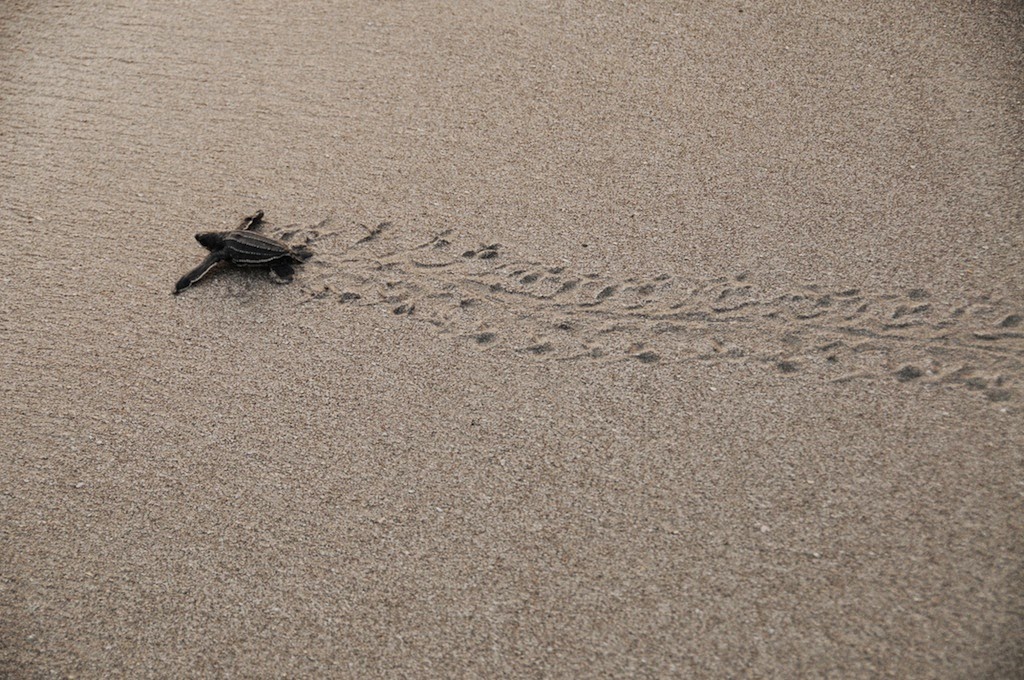The other days as this years interns looked on with
amazement at the spectacle of Olive Ridley Sea
Turtles (Lepidochelys olivacea)
making their first journey into the vast and unknown ocean, I found myself
reminiscing about an experience with sea turtles from a few years ago.
 |
| Olive Ridley Sea Turtles (Lepidochelys olivacea) |
 |
| Olive Ridley Sea Turtles (Lepidochelys olivacea) |
I’m lucky enough to be doing research on the pacific side of
Costa Rica close to the shore, so I have the luxury of being able to go to
places like turtle hatcheries. All sea turtles are facing severe declines in
population sizes, from a various number of sources. One of the main ones is the
harvesting of eggs for human consumption, there is also the factor of them
being predated by a number of species, but here in Costa Rica there is large
concerns with human predation. So organizations have been formed to re-locate
clutches of eggs to areas where they can be monitored and looked after until
the turtles are ready to make the journey into the ocean. Near Montezuma there is a turtle hatchery that
I've visited a lot and became friendly with some of the personal, due to my
aspirations in the field of herpetology. Behind the main area where they talk with visiting onlookers
is a board with information about hatch dates, amongst the forty or line items of
Olive, I spotted two listings for Dermochelys coriacea. My heart raced a little
they had two clutches of Leatherback Sea Turtles or as the call them here,
Baulas. I was instantly thrust back to the memories of being an eight-year-old
child, looking through countless books, gazing with amazement of this
species. It’s the largest living turtle species, reaching total body lengths
sizes of about seven feet and 800 pounds.
Unlike other sea turtles, Leatherbacks have a soft carapace, meaning
they don’t have a hard shell, instead the have a leathery surface, hence the
name. They are one of the deepest diving mammals and are also the fastest
moving reptile in the world. So as a kid these creatures were nothing short of
mythical, I remember having the feeling that they were so far away from me and I
dreamed of seeing one. It appeared as if it was going to happen, I talked with
the attendant and confirmed when they might be hatching. We returned a week latter and to my absolute
astonishment we had timed it right, the first individuals had been seen
making their way to the surface. They let us into the fenced off area where all
the nests were placed to watch and help the process of un-earthing the nest of
Leatherbacks. We started to slowly wade through the sand to see the amazingly
charismatic faces of the turtles starting back up at us. We started to remove
the individuals and put them in a bucket to be brought to the beach.
 |
| Dermochelys coriacea waiting to be released |
I looked
in amazement at this incredible looking species, with their long front flippers almost same size as their body. We finished excavating the individuals from the
deep nest in the sand and headed for the beach. It’s a bit of a spectacle to watch turtles being released on the beach here, so by the time we were ready over 50
people has amassed on the beach, filling in on both sides of the “Turtle runway”. One by one each turtles was released and made
it’s way to the ocean amongst the masses of oh’s and ah’s. Unlike the
Olive-ridleys the Leatherbacks wasted no time, their powerful front flippers lapped themselves into the ocean with a certain impressive gusto. I fondly
took some photos and thoroughly enjoyed the moment that these turtles were the
most important things going on. I thought fondly back to how awesome eight year
old me would have fond this experience, and how much present day me could
really appreciate it.
 |
| Dermochelys coriacea |
 |
| Dermochelys coriacea making it's way to the ocean |
I’m not going to sugar coat it most likely less than 1% of
the individuals we released will reach adult hood. Those aren’t even the
bleakest statistics about this species though.
In the late 80’s the did world wide population estimates for the
species, the number hung around the 100,000 mark. When they redid these numbers
in the early 2000’s the number had dwindled to between 34,000 and 36,000
nesting females. A species that has been around for 100 million years and in a
matter of a few years we’ve reduced them to only 30,000 individuals, is
astonishing and disheartening. Reduction in the usage of plastic bags and are willingness to dump them in the ocean is a huge threat. Because of their abilities to dive deeply they feed predominately on jellyfish, following them as the migrate. Unfortunately for Leatherbacks plastic bags look a lot like jellyfish, they eat the bags than suffocate on them when they get lodged in their throats.
I don’t have the answers for some of the conservation issues
that face this amazing species, but I do try and be vocal about ways to help. I
can’t wait till I finally get to see a full size (alive) individual on the
shores in wild. I relish the thought that I will be in a final generation to
see this species in the wild, I want other kids to look at this species as a
child in astonishment waiting for the day they get to see one in the wild.

No comments:
Post a Comment